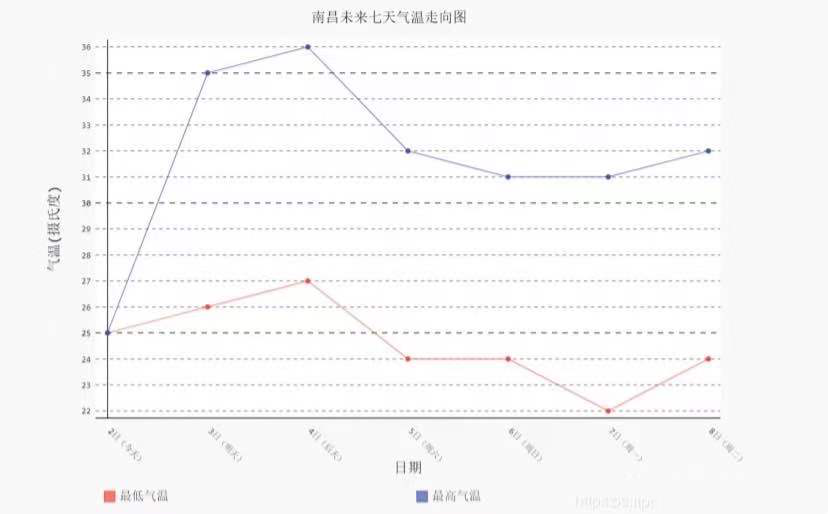溫馨提示×
您好,登錄后才能下訂單哦!
點擊 登錄注冊 即表示同意《億速云用戶服務條款》
您好,登錄后才能下訂單哦!
這篇文章主要介紹python爬蟲之天氣數據分析的示例,文中介紹的非常詳細,具有一定的參考價值,感興趣的小伙伴們一定要看完!
使用pygal繪圖,使用該模塊前需先安裝pip install pygal,然后導入import pygal
bar = pygal.Line() # 創建折線圖
bar.add('最低氣溫', lows) #添加兩線的數據序列
bar.add('最高氣溫', highs) #注意lows和highs是int型的列表
bar.x_labels = daytimes
bar.x_labels_major = daytimes[::30]
bar.x_label_rotation = 45
bar.title = cityname+'未來七天氣溫走向圖' #設置圖形標題
bar.x_title = '日期' #x軸標題
bar.y_title = '氣溫(攝氏度)' # y軸標題
bar.legend_at_bottom = True
bar.show_x_guides = False
bar.show_y_guides = True
bar.render_to_file('temperate1.svg') # 將圖像保存為SVG文件,可通過瀏覽器查看最終生成的圖形如下圖所示,直觀的顯示了天氣情況:

完整代碼
import csv
import sys
import urllib.request
from bs4 import BeautifulSoup # 解析頁面模塊
import pygal
import cityinfo
cityname = input("請輸入你想要查詢天氣的城市:")
if cityname in cityinfo.city:
citycode = cityinfo.city[cityname]
else:
sys.exit()
url = '非常抱歉,網頁無法訪問' + citycode + '.shtml'
header = ("User-Agent","Mozilla/5.0 (Windows NT 10.0; Win64; x64) AppleWebKit/537.36 (KHTML, like Gecko) Chrome/76.0.3809.132 Safari/537.36") # 設置頭部信息
http_handler = urllib.request.HTTPHandler()
opener = urllib.request.build_opener(http_handler) # 修改頭部信息
opener.addheaders = [header]
request = urllib.request.Request(url) # 制作請求
response = opener.open(request) # 得到應答包
html = response.read() # 讀取應答包
html = html.decode('utf-8') # 設置編碼,否則會亂碼
# 根據得到的頁面信息進行初步篩選過濾
final = [] # 初始化一個列表保存數據
bs = BeautifulSoup(html, "html.parser") # 創建BeautifulSoup對象
body = bs.body
data = body.find('div', {'id': '7d'})
print(type(data))
ul = data.find('ul')
li = ul.find_all('li')
# 爬取自己需要的數據
i = 0 # 控制爬取的天數
lows = [] # 保存低溫
highs = [] # 保存高溫
daytimes = [] # 保存日期
weathers = [] # 保存天氣
for day in li: # 便利找到的每一個li
if i < 7:
temp = [] # 臨時存放每天的數據
date = day.find('h2').string # 得到日期
#print(date)
temp.append(date)
daytimes.append(date)
inf = day.find_all('p') # 遍歷li下面的p標簽 有多個p需要使用find_all 而不是find
#print(inf[0].string) # 提取第一個p標簽的值,即天氣
temp.append(inf[0].string)
weathers.append(inf[0].string)
temlow = inf[1].find('i').string # 最低氣溫
if inf[1].find('span') is None: # 天氣預報可能沒有最高氣溫
temhigh = None
temperate = temlow
else:
temhigh = inf[1].find('span').string # 最高氣溫
temhigh = temhigh.replace('℃', '')
temperate = temhigh + '/' + temlow
# temp.append(temhigh)
# temp.append(temlow)
lowStr = ""
lowStr = lowStr.join(temlow.string)
lows.append(int(lowStr[:-1])) # 以上三行將低溫NavigableString轉成int類型并存入低溫列表
if temhigh is None:
highs.append(int(lowStr[:-1]))
else:
highStr = ""
highStr = highStr.join(temhigh)
highs.append(int(highStr)) # 以上三行將高溫NavigableString轉成int類型并存入高溫列表
temp.append(temperate)
final.append(temp)
i = i + 1
# 將最終的獲取的天氣寫入csv文件
with open('weather.csv', 'a', errors='ignore', newline='') as f:
f_csv = csv.writer(f)
f_csv.writerows([cityname])
f_csv.writerows(final)
# 繪圖
bar = pygal.Line() # 創建折線圖
bar.add('最低氣溫', lows)
bar.add('最高氣溫', highs)
bar.x_labels = daytimes
bar.x_labels_major = daytimes[::30]
# bar.show_minor_x_labels = False # 不顯示X軸最小刻度
bar.x_label_rotation = 45
bar.title = cityname+'未來七天氣溫走向圖'
bar.x_title = '日期'
bar.y_title = '氣溫(攝氏度)'
bar.legend_at_bottom = True
bar.show_x_guides = False
bar.show_y_guides = True
bar.render_to_file('temperate.svg')以上是python爬蟲之天氣數據分析的示例的所有內容,感謝各位的閱讀!希望分享的內容對大家有幫助,更多相關知識,歡迎關注億速云行業資訊頻道!
免責聲明:本站發布的內容(圖片、視頻和文字)以原創、轉載和分享為主,文章觀點不代表本網站立場,如果涉及侵權請聯系站長郵箱:is@yisu.com進行舉報,并提供相關證據,一經查實,將立刻刪除涉嫌侵權內容。